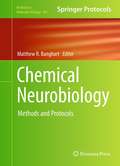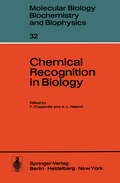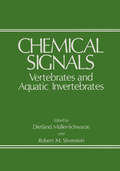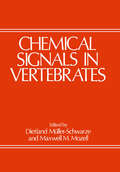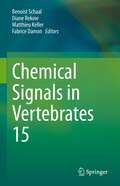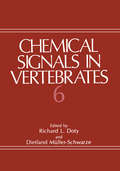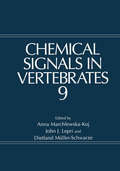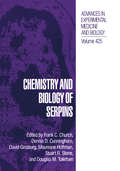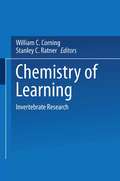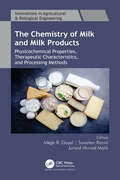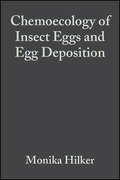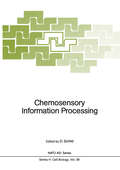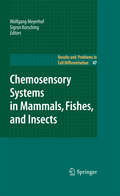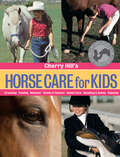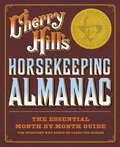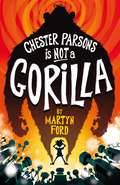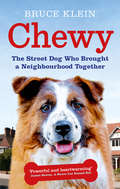- Table View
- List View
Chemical Mutagens: Principles and Methods for Their Detection
by Frederick J. Serres Alexander HollaenderNew developments in the study of environmental mutagens continue to evolve in this rapidly emerging field. In Volume 7 of Chemical Mutagens, we have focused on various new techniques for the detection of genetic damage in somatic cells and germ cells of mammals and the use of lower eukaryotic microorganisms to detect aneuploidy as well as other types of genetic damage. Attention has also been given to the role of in vitro metabolic activation as a mechanism for modifying the genetic effects of different environmental chemicals. In a chapter on compar ative mutagenesis, reaction kinetics and their relationship to the mu tagenic action of monofunctional alkylating agents in higher eukaryotic organisms are examined. In another chapter, the pharmacology and toxicology of nitrites and nitrates, which are in widespread distribution in the environment, are discussed in detail. The books in this series have provided a mechanism for the publication of many important new developments in the study of the genetic effects of environmental chemicals. This series was launched by Dr. Alexander Hollaender who, beginning in 1971, edited Volumes 1-4 and then coedited Volumes 5-7. The success of his lO-year effort with these volumes is another testimony to Dr. Hollaender's many contri butions to the field of environmental mutagenesis. As Dr.
Chemical Neurobiology: Methods and Protocols (Methods in Molecular Biology #995)
by Matthew R. BanghartMany advances in modern neuroscience are enabled by the availability of chemical tools that allow sensitive, precise, and quantitative measurements of, and control over, biological processes. These powerful reagents are widely used for investigating the nervous system at levels of detail ranging from ion channel structure to neural network dynamics. Recent advances in photochemistry, microscopy, and protein engineering have triggered a surge in the development and application of these interdisciplinary techniques. Chemical Neurobiology: Methods and Protocols assists with the design, characterization and validation of new chemical tools for neurobiology by providing detailed protocols of procedures and assays deemed essential for the successful development and implementation of such tools. Divided into three sections, topics cover chemical probes of membrane protein structure and function, photochemical control of protein and cellular function, and chemical probes for imaging in the nervous system. Written in the successful Methods in Molecular Biology™ series format, chapters include introductions to their respective topics, lists of the necessary materials and reagents, step-by-step, readily reproducible protocols, and notes on troubleshooting and avoiding known pitfalls. Authoritative and easily accessible, Chemical Neurobiology: Methods and Protocols serves scientists at many levels, including students aiming to expand their perspective, laboratory researchers seeking technical guidance, and established investigators looking for creative solutions to their research problems in molecular, cellular and systems neuroscience.
Chemical Recognition in Biology (Molecular Biology, Biochemistry and Biophysics Molekularbiologie, Biochemie und Biophysik #32)
by F. Chapeville A. L. HaenniStudies of chemical recognition in biology were initiated about half a century ago with the flrst kinetic data obtained on enzyme catalysis and inhibition. They led to a rather static representation of the recognition process illustrated by the lock and key model that still continues to influence our overall image of recognition and its specificity. In several cases, crystallographic studies of enzyme-substrate complexes have supported this model. Indeed, in a crystallized ligand-enzyme complex, a close fltting is observed between the active center of the enzyme and the functional groups of the ligand. How ever, this does not necessarily result from a direct recognition process between rigid structures, but may result from a progressive adaptation during which the initial struc tures of the enzyme and the ligand are modified (induced-flt mechanism). Recently, a great deal of work has been devoted to the study of recognition in more complex systems such as the replication or the translation machin~ries; clearly, the extraordinary precision of such systems cannot be explained solely in terms of physical matching between enzymes and their substrates. This has led to a noticeable change of perspective in these areas. As a result of the new kinetic viewpoint, one rather focuses on the time-course of the processes, on the kinetic balance between steps of the reaction, on the energy-accuracy relationships and on the strategies which permit the achievement of high precision using relatively error-prone components in an appropriate dynamic interplay.
Chemical Signals: Vertebrates and Aquatic Invertebrates
by D. Muller-SchwarzeResearch on chemical communication in animals is in a very active and exciting phase; more species are studied, data are accumulating, concepts are changing, and practical application seems feasible. While most of the work on chemical ecology and chemical sig nals deals with insects, vertebrate communication provides a formidable challenge and progress has been slow. Joint efforts and frequent direct contacts of ecologists, behaviorists, psychologists, physiologists, histologists and chemists are required. Such an interdisciplinary exchange of information took place on the occasion of the Symposium on Chemical Signals in Vertebrates and Aquatic Animals in Syracuse, New York, from May 31 to June 2, 1979. More than one hundred investigators from seven countries participated, and the papers presented comprise this volume. Since the first Symposium on Vertebrate Chemical Signals at Saratoga Springs in 1976, considerable progress has been made with field studies, the physiology of the vomeronasal organ, and its role in reproductive behavior. The behavioral functions and chemi cal nature of priming pheromones are better understood. Efforts to isolate and identify mammalian pheromones are gaining ground, and the bioassays are becoming more sophisticated. In addition to formal presentations, one evening of the Symposi um was devoted to round-table discussions of particular topics. The selected themes indicate the "growing points" of chemical communi cation research: priming pheromones, vomeronasal organ, bioassay, and practical applications.
Chemical Signals in Vertebrates
by Dietland Muller-SchwarzeFrom June 6 to 9, 1976, about 140 participants (physiologists, chemists, ecologists, animal behaviorists, and psychologists) gathered in the Gideon Putnam Hotel at Saratoga Springs, New York for a symposium entitled "Chemical Signals in Vertebrates". The focus of this symposium, sponsored by the United States National Science Foundation, was on chemical communication in higher animals, most notably mammals. This included the chemical nature, production, and reception of chemical signals, and their modulating effects on behavior. Almost all the world's laboratories working in this area were represented. It was the first meeting of its kind, and although the physiological aspects of taste and smell on the one hand and insect pheromones on the other have previously been treated in several fine symposia, they have not before been treated as a back drop to chemical communication in vertebrates. The field of insect pheromones is well developed, with hundreds of active compounds identified. By contrast, in vertebrates only six mammalian phero mones in as many species had been identified chemically by 1976.
Chemical Signals in Vertebrates 10
by Dietland Müller-Schwarze R. T. Mason Michael P. LemasterThe editors and contributors to this volume should be justifiably proud of their participation in the tenth triennial meeting of the Chemical Signals in Vertebrates International Symposium. This meeting was held 27 years after the initial gathering of participants in Saratoga Springs, New York from June 6* to 9*, 1976. Subsequent meetings have been held every three years in Syracuse, New York; Sarasota, Florida; Laramie, Wyoming; Oxford, England; Philadelphia, Pennsylvania; Tubingen, Germany; Ithaca, New York; and Krakow, Poland. This tenth aimiversary symposium was held from July 29* through August 1*' in Corvallis, Oregon and was hosted by the Zoology Department and Biology Programs of Oregon State University. This book also represents the tenth in a series of books on chemical communication, chemical ecology, olfactory and vomeronasal research in vertebrate species. The species covered in the chapters herein range from fish to mammals including humans. By taxonomic breakdown the mammals are the most represented in number of species and chapter contributions. However, the hosts of the meeting endeavored to have some representative contributions covering all of the major vertebrate taxa. As in past years, the meeting was well-represented with just over 100 participants from 13 different nations. Plenary talks focused on some of the non-mammalian groups that have tended to be less represented in these symposia. Thus, we had a very nice overview of comparisons and contrasts of invertebrate chemical commimication to vertebrate systems.
Chemical Signals in Vertebrates 11
by Jane Hurst Robert J. Beynon S. Craig Roberts Tristram WyattThis volume contains the proceedings of the conference of the same name held in July 2006 at the University of Chester in the United Kingdom. It includes all the latest research on chemical communication relevant to vertebrates, particularly focusing on new research since the last meeting in 2003. Topics covered include the chemical ecology, biochemistry, behavior, olfactory receptors, and the neurobiology of both the main olfactory and vomeronasal systems of vertebrates.
Chemical Signals in Vertebrates 13
by Bruce A. Schulte Thomas E. Goodwin Michael H. FerkinIn 2014, the Chemical Signals in Vertebrates (CSiV) group held its 13th triennial meeting in conjunction with the 30th meeting of the International Society of Chemical Ecology (ISCE). The meeting convened on the campus of the University of Illinois at Urbana-Champaign. This meeting was the first held jointly with these two groups, which share common history and are dedicated to understanding the role of chemical communication in the lives of organisms. This volume is a collection of the proceedings of this meeting and, like the meeting, cover a variety of topics in chemical ecology, including Chemical Ecology of Social Behavior; Chemical Signals – Analysis and Synthesis; Evolution, Genomics, and Transcriptomics of Chemical Signals; Molecular Mechanisms of Semiochemical Perception and Processing; Multimodal Communication; and Neuroethology and Neurophysiology.
Chemical Signals in Vertebrates 14
by Christina D. BueschingIn August 2017, the Chemical Signals in Vertebrates (CSiV) group held its 14th triennial meeting at Cardiff University in Wales. This well established international conference brings together leaders and students in the field of olfactory communication and chemical signaling of vertebrates to present new advances in their research as well as synopses of disparate areas under new angles. This volume is a collection of the proceedings of this meeting authored by leading experts in this field that covers a wide variety of topics in chemical ecology.
Chemical Signals in Vertebrates 15
by Benoist Schaal Diane Rekow Matthieu Keller Fabrice DamonThe 15th Meeting on Chemical Signals in Vertebrates (CSiV) reunited participants from 20 countries from 5 continents who "electronically commuted" to Dijon, France, during three days (3-5 November 2021). This virtual meeting was a great opportunity to share information on how amphibians, reptiles, birds, and mammals communicate through chemosignals and integrate their environment through chemical cues. Scientists from varied disciplines ranging from biology and psychology to chemistry and biostatistics attended the meeting to share their research on how vertebrates produce and release chemical cues and signals, how they detect, discriminate, process, and interpret them; how they respond to them behaviorally, physiologically, and/or neurally in adaptive ways; how the typical or atypical environment modulates such chemocommunication loops, and chemoreception in general. In total, this 2021 CSiV meeting presented important new findings, representative of the growing points in the rapidly expanding field of research on chemocommunication among vertebrates. As appreciated by D Müller-Schwarze (a well-known pioneer in the field and the founding father of the book series in question) in his foreword to the meeting, “Our field has broadened to new horizons: besides multicomponent cues, we now learn about multisource and multifunction chemical signals. The range of study animals and settings has become richer, and we have learned enough that practical applications are becoming realistic.” This proceedings documents key presentations from this virtual conference.
Chemical Signals in Vertebrates 6
by R. L. Doty Dietland Müller-SchwarzeThis volume is an up-to-date treatise of chemosensory vertebrate research performed by over 200 scientists from 22 countries. Importantly, data from over 25 taxa of vertebrates are presented, including those from human beings. Unlike other volumes on this topic, a significant nurober of the contributions come from leading workers in the former Soviet Union and reflect studies within a wide variety of disciplines, including behavior, biochemistry, ecology, endocrinology, genetics, psychophysics, and morphol ogy. Most of the studies described in this volume were presented at the Chemical Signals in Vertbrates VI (CSV VI) symposium held at the University of Pennsylvania in the summer of 1991. This international symposium was the largest and the most recent of a series of six such symposia, the first of which was held in Saratoga Springe, New York (June 6-9, 1976) and the last in Oxford, England (August 8-10, 1988). Unlike the previous symposia, Chemical Signals in Vertabrates VI lasted a full week, reflecting the increased number of participants and the desire of many to present their research findings orally to the group as a whole.
Chemical Signals in Vertebrates 9
by Anna Marchlewska-Koj John J. Lepri Dietland Müller-SchwarzeIt is generally accepted that the recent progress in molecular and cellular biology would not have been possible without an understanding of the mechanisms and signaling pathways of communication inside the cell and between various cells of the animal organism. In fact a similar progress occurred in the field of chemical communication between individual organisms of vertebrate species, and this volume is aimed at presenting the current state of the art on this subject. The reader can find here both original results obtained in the laboratory or field studies and comprehensive reviews summarizing many years of research. The presentations of over 60 scientists have been grouped according to their approach into nine parts covering such fields as ecological and evolutionary aspects of chemical communication, structure and neuronal mechanisms of chemosensory systems, chemical structure of pheromones and binding proteins, kin, individual and sexual recognition, predator-prey relationships, purpose and consequences of marking behavior, scent signals and reproductive processes. Expanding on former volumes of this series, entirely new chapters have been added on prenatal chemical communication describing specific effects of the intrauterine environment. In many cases a truly multidisciplinary approach was required, such as with the population analysis of polymorphic variants of the mouse's major urinary proteins that function in carrying pheromones.
Chemistry and Biology of Serpins (Advances in Experimental Medicine and Biology #425)
by Frank C. Church Dennis D. Cunningham David Ginsburg Maureane R. Hoffman Stuart R. Stone Douglas M. TollefsenProceedings of an International Symposium held in Chapel Hill, North Carolina, April 13-16, 1996
Chemistry of Learning: Invertebrate Research (pdf)
by Stanley C. Ratner W. C. Corning NA American Institute of Biological SciencesThe Chemistry of Milk and Milk Products: Physicochemical Properties, Therapeutic Characteristics, and Processing Methods (Innovations in Agricultural & Biological Engineering)
by Megh R. Goyal Suvartan Ranvir Junaid Ahmad MalikMilk and milk products are highly nutritious, yet their low acidity provides a favorable environment for growth of pathogenic and spoilage-causing organisms. To avoid this, milk requires specialized processes to be converted into various milk products to ensure safety and quality. This new volume provides an understanding of the manufacturing processes of milk products and the structural, physicochemical, and compositional changes that occur during manufacturing and storage of milk products and the impact on quality. It covers methods of conversion of milk into high-value, concentrated, extended shelf-life and easily transportable dairy products. It delves into the constituents and chemistry, physicochemical properties, and therapeutic characteristics of milk and milk products, and then goes on to present specialized processing methods. Specialized methods such as proteolysis in ultra-high temperature (UHT), heat and acid coagulation of milk products, processing and characteristics of dry dairy milk powders, and methods to monitor pesticide residues in milk and milk products are presented and evaluated.
The Chemistry of Milk and Milk Products: Physicochemical Properties, Therapeutic Characteristics, and Processing Methods (Innovations in Agricultural & Biological Engineering)
by Megh R. Goyal Suvartan Ranvir Junaid Ahmad MalikMilk and milk products are highly nutritious, yet their low acidity provides a favorable environment for growth of pathogenic and spoilage-causing organisms. To avoid this, milk requires specialized processes to be converted into various milk products to ensure safety and quality. This new volume provides an understanding of the manufacturing processes of milk products and the structural, physicochemical, and compositional changes that occur during manufacturing and storage of milk products and the impact on quality. It covers methods of conversion of milk into high-value, concentrated, extended shelf-life and easily transportable dairy products. It delves into the constituents and chemistry, physicochemical properties, and therapeutic characteristics of milk and milk products, and then goes on to present specialized processing methods. Specialized methods such as proteolysis in ultra-high temperature (UHT), heat and acid coagulation of milk products, processing and characteristics of dry dairy milk powders, and methods to monitor pesticide residues in milk and milk products are presented and evaluated.
Chemoecology of Insect Eggs and Egg Deposition
by Monika Hilker Torsten MeinersThis is the first book focusing on the chemoecology of insect eggs and egg deposition. It covers a wide range of different issues including herbivorous and carnivorous insects, social insects and those of medical and veterinary importance. The knowledge compiled in this book may promote future studies on evolutionary aspects on insect reproductive behaviour as well as on controlling insect pests by targeting the egg stage.
Chemosensory Information Processing (Nato ASI Subseries H: #39)
by Detlev SchildIn July 1989 a symposium was held at the Physiology Department of the Georg August University, G6ttingen, on the physiological, biophysical, biochemical, and technical principles of the coding of chemical substances both in nervous systems and artificial devices. This book is the collection of the papers presented at that meeting. Biological and artificial systems for odor coding both have in common that the stimulus selectivity of the receptor cells (sensors) is usually very poor, and the mechanisms which determine selectivity and sensitivity are largely unknown. However, a poor selectivity allows the coding of an enormous number of stimuli by combinations of receptor activities. In the field of chemosensory information coding there are thus two major problems: the function of the receptors and the network that processes and evaluates the primary information of the sensors. Accordingly, this volume has three parts: sensors, the network following the sensors, and the coding in this network. The expert secretarial assistance of M. Holtmann in preparing the camera-ready manuscript is gratefully acknowledged. D. Schild G6ttingen, August 1989 CONTENTS l. Response of olfactory receptor cells, isolated and in situ, to low concentrations of odorants 1 Stephan Frings, Bernd Lindemann 2. Excitation and adaptation of frog olfactory receptor neurones upon stimulation with second messengers and natural odorants 9 D. Schild, J. A. DeSimone, S. Hellwig 3. Receptor selectivity and dimensionality of odours at the stage of the olfactory receptor cells 21 GiJJes Sicard 4.
Chemosensory Systems in Mammals, Fishes, and Insects (Results and Problems in Cell Differentiation #47)
by Sigrun Korsching Wolfgang MeyerhofThe sense of smell has an essential role in locating food, detecting predators, navigating, and communicating social information. Accordingly, the olfactory system has evolved complex repertoires of receptors to face these problems. Although the sense of taste has less far-reaching tasks, they are every bit as essential for the animals well-being, allowing it to reject toxic materials and to select nutritionally valuable food. The last decade has seen a massive advance in understanding the molecular logic of chemosensory information processing, beyond that already achieved in the rst few years following Linda Bucks discovery of odorant receptors. Shortly afterwards, the major principles of olfactory representation had been established in mammals as the one neuron/ one receptor rule and the convergence of neurons, which express the same receptor, onto individual modules in the olfactory bulb. In recent years, such studies have been extended to lower vertebrates, including shes and other phyla, i. e. , arthropods, worms, and insects, showing both the general validity of these concepts and some exceptions to the rule. In parallel, hallmarks of the molecular logic of taste sensation have been deciphered and found to differ in interesting ways from those of smell sensation.
Cherry Hill's Horse Care for Kids: Grooming, Feeding, Behavior, Stable & Pasture, Health Care, Handling & Safety, Enjoying
by Cherry HillCovering the essentials of equine care in a language appropriate for teen and preteen horse lovers, this guide provides everything young equestrians need to know to safely and enjoyably keep their horse healthy and happy. Veteran trainer Cherry Hill starts by making sure that the right animal is matched with the right rider, then progresses through feeding, grooming, behavior, safety, and health care. Encouraging their passion, Hill provides a roadmap for young horse enthusiasts to responsibly care for their cherished companion.
Cherry Hill's Horsekeeping Almanac: The Essential Month-by-Month Guide for Everyone Who Keeps or Cares for Horses
by Cherry HillKeep your horse happy and healthy throughout the entire year. Veteran trainer Cherry Hill provides a comprehensive month-by-month guide to horse care that includes seasonal stable chores and maintenance procedures that promote equine health. Reminding you to check for ticks in April, buy hay in July, and set up winter bedding in October, each month&’s reference charts, to-do lists, and climate notes will help you establish routines that follow the natural cycles of the animals and the land.
Cherry Moon: Little Poems Big Ideas Mindful of Nature
by Zaro WeilWinner of the CLPE Award for Children's Poetry 2020. This dazzling poetry collection bubbles with excitement and creativity, capturing the sheer joy of the natural world. Discover parades of beast-doodles, preposterous penguins, talking blossoms, playful birds, humble fleas and a host of other exotic and everyday creatures who jump off the page and into our hearts.Thought-provoking, delightfully original and beautifully illustrated, Cherry Moon will encourage children of every age to explore the power, enchantment and wonderfulness of poetry and nature.
Chester Parsons is Not a Gorilla
by Martyn FordWhen Chester discovers he can mind jump, his sister Amy wastes no time in putting his new skills to work boosting the viewing figures on her video blog. And when a TV company takes them global, he does his most daring mind jump yet, into the brain of Tito the gorilla. The trouble is, when he tries to return to his own body - it's gone!Has it been stolen? But who would want it, and why? And how come Chester suddenly has the urge to search Amy's hair for fleas? The quest to find the answers takes him on a journey beyond his wildest imagination.A fast-paced, mind-boggling and hilarious yet thought-provoking read from the author of The Imagination Box series.
Chewy: The Street Dog who Brought a Neighbourhood Together
by Bruce Klein"I really enjoyed Chewy – a book with a powerful and heart-warming message. In a world where old-fashioned notions like community, closeness and neighbourliness seem to have been lost, it is one of those unexpected stories that restore your faith in our collective nature. It also reminds us, once again, what an important role animals can play in our lives" - James Bowen, author of A Street Cat Named BobThe first time Bruce Klein caught sight of Chewy, this beautiful street dog captured his heart.Chewy had been a stray since he was a puppy. Sometimes he travelled with other street dogs, but more often he made his rounds alone. Bruce began to feed this timid St Bernard Cross, and he soon met other locals who looked out for Chewy too. The neighbours saw Chewy shivering in the winter rain, and knew it would only be a matter of time until the local animal control put him down. Bruce was happy to take him home, but Chewy was big and frightened. Rescuing him wouldn’t be simple – the neighbours had to devise a plan ...Chewy is the uplifting true story of how a whole neighbourhood came together to change one dog’s life. It will capture your heart too.
Chewy Hughie: Band 07/Turquoise (Collins Big Cat)
by Jane Clarke Sarah McConnell Cliff Moon Collins Big CatChewy Hughie chews anything and everything he can get his paws on, driving his owners to distraction! But what happens when Chewy Hughie discovers a packet of bubblegum… This is a lively rhyming story by Jane Clarke, illustrated with stunning artwork from Sarah McConnell. Pages 14-15 provide a storymap of the house, which consolidates understanding, and provides a wealth of speaking and listening opportunities. Turquoise/Band 7 books offer literary language and extended descriptions, with longer sentences and a wide range of unfamiliar terms. This book has been levelled for Reading Recovery.

